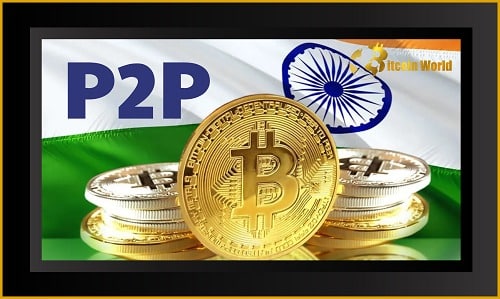Are you an Indian crypto enthusiast finding it increasingly difficult to navigate the banking restrictions on cryptocurrency transactions? You’re not alone. As Indian banks and payment processors tighten their grip on crypto, a fascinating workaround is gaining traction: Peer-to-Peer (P2P) crypto exchanges. Let’s dive into how these platforms are becoming a lifeline for Indian crypto traders, enabling them to buy and sell Bitcoin and other cryptocurrencies despite the regulatory headwinds.
Why are Indian Crypto Exchanges Turning to P2P?
Imagine this: you want to buy Bitcoin, but your usual payment methods are blocked from connecting with crypto exchanges. This is the reality many Indian crypto traders face. To circumvent these limitations, several Indian crypto exchanges have embraced peer-to-peer (P2P) transfers. Here’s how it works:
When you place a buy order on a P2P exchange, the platform acts as a connector, linking you directly with a seller. Instead of sending money to the exchange itself, you directly transfer funds to the seller via traditional methods like bank transfers or other payment mechanisms. Once the seller confirms receipt, the exchange releases the cryptocurrency from their wallet into yours.
Key takeaway: No money flows directly from banks or payment systems to the exchange, effectively sidestepping the payment blockades.
The Blockade: Understanding Cryptocurrency Payment Challenges in India
The shift towards P2P isn’t arbitrary. It’s a direct response to the increasingly complex regulatory landscape for cryptocurrency payments in India. Recent reports highlight that these measures are a reaction to growing restrictions imposed on payment networks within the country.
An executive from a crypto exchange, quoted by local media, candidly stated:
“This is not how an exchange should be functioning. It’s certainly less efficient. But apparently there is no violation of any regulation or law. It’s a simple money transfer from A to B.”
Let’s break down the challenges:
- RBI Warnings: The Reserve Bank of India (RBI) has consistently cautioned payment processors against facilitating transactions with crypto exchanges.
- Coinbase’s India Setback: A prime example is Coinbase. Shortly after launching in India, they were compelled to suspend their payment partner due to governmental pressure. Their initial plan to leverage the Unified Payments Interface (UPI), a widely used payment service in India, was thwarted by banking officials who claimed unawareness of any exchanges using UPI.
- CoinSwitch Kuber’s Payment Halt: Another major Indian exchange, CoinSwitch Kuber, also had to disable crypto deposits and withdrawals via their payment network.
These events underscore a clear trend: banks are tightening their control over digital asset transactions, leaving Indian crypto users with dwindling options for seamless fiat-to-crypto and crypto-to-fiat conversions.
P2P: Getting Around the Bankers – A Viable Solution?
In the face of these challenges, P2P emerges as an alternative route. Some exchanges are now directly accepting funds from customers into their bank accounts. After verifying the deposit, the exchange credits the user’s crypto wallet, enabling them to trade digital assets.
Is this a foolproof solution? While P2P offers a workaround, legal experts suggest potential regulatory gray areas.
According to a legal perspective:
“If it’s perceived that by directly accepting funds from buyers, an exchange is offering some kind of a wallet facility to the trader, there would be regulatory issues.”
Potential Concerns with Direct Bank Transfers:
- Regulatory Scrutiny: Directly accepting funds could be interpreted as providing unauthorized wallet services, attracting regulatory attention.
- Efficiency and Scalability: Managing direct bank transfers for a large user base can be operationally complex and less efficient than automated payment gateways.
Despite these concerns, P2P exchanges are currently providing a crucial service, allowing Indian traders to remain active in the crypto market. However, the long-term sustainability and regulatory acceptance of this model remain to be seen.
The Bigger Picture: Capital Flight and the Future of Indian Crypto
The stringent banking environment is already pushing some Indian investors and traders to move their funds to international exchanges. While this offers an alternative, India’s banking restrictions make even this route challenging, necessitating even more creative circumvention strategies.
As India navigates its crypto regulatory journey, the rise of P2P exchanges highlights the resilience and adaptability of the crypto community. Whether P2P remains a long-term solution or a temporary fix in a constantly evolving landscape is a question that the coming months and regulatory decisions will answer.
In Conclusion:
P2P crypto exchanges in India are stepping up as a critical alternative in the face of banking restrictions. They offer a way for Indian traders to continue participating in the crypto market, albeit with potential complexities and regulatory uncertainties. The situation underscores the ongoing tension between regulatory control and the decentralized nature of cryptocurrencies, particularly in a major emerging market like India. Keep watching this space as the future of crypto in India continues to unfold.
Related Posts – Ferrari joins the NFT universe through a collaboration with a Swiss…
Disclaimer: The information provided is not trading advice, Bitcoinworld.co.in holds no liability for any investments made based on the information provided on this page. We strongly recommend independent research and/or consultation with a qualified professional before making any investment decisions.


